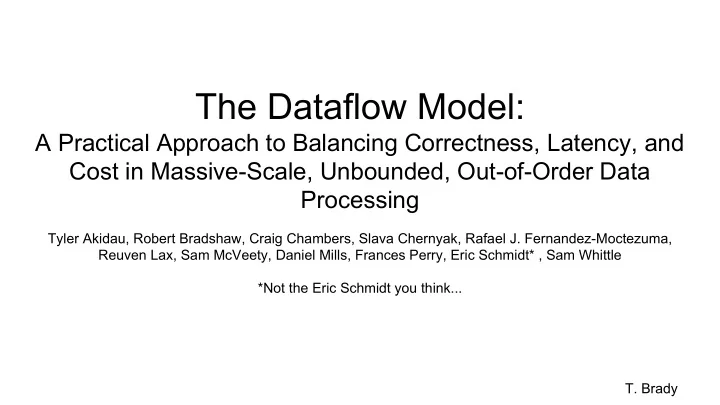

The Dataflow Model: A Practical Approach to Balancing Correctness, Latency, and Cost in Massive-Scale, Unbounded, Out-of-Order Data Processing Tyler Akidau, Robert Bradshaw, Craig Chambers, Slava Chernyak, Rafael J. Fernandez-Moctezuma, Reuven Lax, Sam McVeety, Daniel Mills, Frances Perry, Eric Schmidt* , Sam Whittle *Not the Eric Schmidt you think... T. Brady
Problem ● Unbounded, unordered datasets ○ Web logs ○ Mobile usage statistics ○ Sensor networks ● Users have complex requirements: ○ Event-time ordering ○ Windowing by features of the data ○ Low latency ● One can never fully optimize along all dimensions of correctness, latency, and cost. ● How do we reconcile these conflicting requirements?
Previous Work: Need for Data Processing ● Mapreduce, Hadoop, Pig, Hive, Spark enabled scale ● SQL Systems enabled ○ Query systems ○ Windowing ○ Data Streams ○ Time Domains ○ Semantic Models ● Spark streaming, Millwheel, Storm enabled low-latency processing
But something is missing Performance: Many good solutions but none have everything we want ● High Latency - batch systems ● Not Fault Tolerant at Scale - Aurora, TelegraphCQ, Niagara, Esper ● Fail on Correctness - Pulsar, Storm, Samza (No Exactly once semantics) ● Lack Expressiveness - MillWheel and Spark Streaming (Need for high-level models) ● Too Complex - Lambda Architecture Systems (Need to maintain batch and stream) Paradigm: ● Focus on input data as something which at some point will become complete ● Nearly all distinguish batch and streaming
Key Aim of Paper: Shift In Approach “Fully embrace the assumption that we never know if or when we have seen all of our data , only that data will arrive, old data may be retracted , and the only way to make the problem tractable is via principled abstractions that allow the practitioner the choice of appropriate tradeoffs between correctness, latency and cost .” “ Execution engine [should not] dictate system semantics ; properly designed and built batch, micro-batch, and streaming systems can all provide equal levels of correctness”
Contribution: The Dataflow Model ● A Unified Model allowing: ○ Event-time ordered results windowed by features of the data themselves ○ Unbounded, unordered data source ○ Correctness, Latency, and Cost tunable ● Decomposes pipeline implementation across four related dimensions, providing clarity, composability and flexibility ○ What results are being computed ○ Where in event time they are being computed ○ Where in processing time they are materialized ○ How earlier results relate to later refinements ● Separates logic of data processing from the underlying physical implementation ○ choice of batch, micro-batch, or streaming engine → correctness, latency, and cost.
What time is it? ● Event time - time at which event actually occurred , never changes (e.g. when someone searched for “dog”) ● Processing time - time at which event is observed at a given point during processing ○ changes as moves event moves through pipeline ● No global clock
Primitives: What results are being computed Two Core Transforms ● ParDo - generic parallel processing ○ Translates well to unbounded data ● GroupByKey - grouping (key, value) pairs ○ Not so easy with unbounded data
Windowing Model: Where in event time results are computed ● Window: Time-based slices of dataset for processing as a group ● Aligned - applied across all data ● Unaligned - applied across given subset (e.g. per key)
Windowing Model: Where in event time results are computed ● Two operations ○ Set<Window> AssignWindows(T datum) ○ Set<Window> MergeWindows(Set<Window> windows) ■ Typically redefine GroupByKey to GroupByKeyAndWindow ● Instead of (key,value) pairs, system is now handling (key, value, event time, window)
Windowing Model : GroupByKeyAndWindow
Windowing Model: In Practice ● E.g. Window data into 30 minute sessions
Triggering Model: When in processing time results are materialized ● Mechanism for stimulating the production of GroupByKeyAndWindow results in response to internal or external signals ● Allows you to control latency
Incremental Model: How earlier results relate to later refinements ● Discarding ● Accumulating ● Accumulating and Retracting
Putting it all together What results are being computed Where in event time they are being computed When in processing time they are materialized How earlier results relate to later refinements “Session windowing with 1 minute timeout, enabling retractions” ● Sessions joined as more data received ● Results retracted as more data received
Contribution: The Dataflow Model ● A Unified Model allowing: ○ Event-time ordered results windowed by features of the data themselves ○ Unbounded, unordered data source ○ Correctness, Latency, and Cost tunable ● Decomposes pipeline implementation across four related dimensions, providing clarity, composability and flexibility ○ What results are being computed ○ Where in event time they are being computed ○ When in processing time they are materialized ○ How earlier results relate to later refinements ● Separates logic of data processing from the underlying physical implementation ○ choice of batch, micro-batch, or streaming engine → correctness, latency, and cost. ● Scalable implementations on FlumeJava and Millwheel
How does it stack up? ● Low latency ○ via windowing and triggering ● Scalable and Fault Tolerant ○ Millwheel, FlumeJava ● Correctness ○ Incremental model with accumulations and retractions ● Greater Expressiveness ○ Windowing by features, complex triggering ● Reduced Complexity ○ Abstracted, Unified framework
But No Magic Bullet ● That which was impractical in existing systems remains so ○ Framework for parallel computation independent of underlying execution engine ○ Balance latency, correctness for a problem ● Aimed at ease of use, pragmatic, real world massive scale data processing ● Hard to reason about the underlying performance. ● What is the Complexity of these operations? ● What is the Overhead ? ● Abstractions mean less control ○ Where is my computation happening? ○ But that’s the point of Dataflow Model... ○ Do I need to know? ● Paper doesn’t explore how this model is to be implemented ○ But open source is available
Thank You. Questions?
Recommend
More recommend